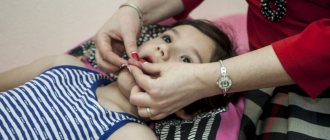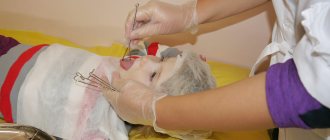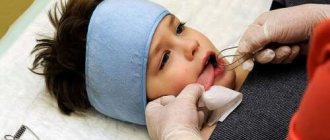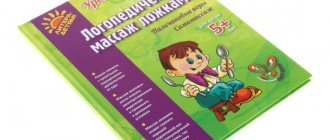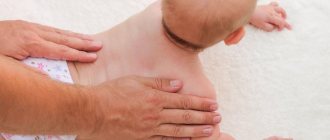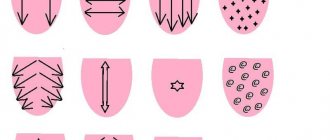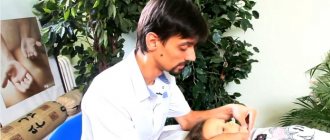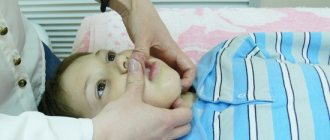A tongue massager is a special device designed for speech therapy massage, and also performs the function of cleansing the surface of the tongue. Used to prepare the articulatory muscles of the mouth for further classes with a speech therapist.
A speech therapy massager helps young children develop and correct speech. By regularly performing massage actions, the electric massager helps reduce the time for speech correction by up to 5 times compared to conventional massage probes.
Externally, the shape of the product resembles a regular toothbrush with a diameter no larger than that of a ballpoint pen. It runs on electric batteries.
The body of an electrical device can be made of either aluminum or plastic. Inside there is a vibrator with a battery. The kit also includes replaceable tips that change depending on the impact.
The product comes with a special “Scraper” attachment, which is multifunctional. Can be used for both oral and facial massage. It strengthens the lateral edges of the tongue especially well, shapes its upper rise and helps to produce sounds.
Replaceable attachments are mainly made of food-grade plastic, do not contain dyes and can withstand sterilization with UV lamps. There can be two types: soft and hard. Soft attachments are designed for a relaxing massage, and hard ones for an energizing massage.
Indications for use may be: dyslalia, dysarthria, stuttering, rhinolalia, as well as infantile type of swallowing.
Contraindicated in children and adults with active epilepsy, as well as in children under three years of age.
Read articles on the topics:
Orthopedic mattresses for children - how to choose the right one
Features of the prevention of flat feet in childhood
Orthopedic chair for a child: types and secrets of choice
The operation of the electric massager is based on the effect of high-frequency vibrations on the surface of the tongue, chin and cheeks. As a result, the muscles either relax or become toned. The result depends on the attachments used. It also helps tone and tone the facial muscles and articulation muscles. Improves blood circulation in the massage area.
It is important to consider that before using the “vibration” technique, the tongue must first be prepared by kneading, rubbing and stroking it. Actions are carried out manually. Only after this the vibration function is performed.
Types of logomassage
Various types of logomassage are used to work with children. The most common types are:
- traditional;
- probe;
- self-massage;
- hardware;
- point;
- Dyakova massage.
Logomassage
The traditional version uses classic massage techniques. For the probe, special tools are used. In this case, only those who have undergone appropriate training can perform massage.
Self-massage allows you to train the patient to do logomassage without the help of a specialist. For hardware procedures, special devices are used (vacuum, vibration and others).
Tochochny uses traditional medicine methods to work with children.
Important! Dyakova massage is a technique that allows you to effectively combat speech disorders in children.
Goals of speech therapy massage
Massage is intended to help a child in the following cases:
- The baby is unable to pronounce words and sentences with the required degree of clarity.
- If your child suffers from stuttering.
- The muscles that are involved in articulation do not have good tone.
- When the development of the speech apparatus at the age of three years occurs with deviations of an unclear nature.
- Sometimes speech deficiencies can manifest themselves not only in oral, but also in written speech. This massage can help in cases where dysgraphia is not associated with delayed internal development.
- For dysarthria.
A child shouldn't be afraid
- Often, delays in speech development occur simultaneously with problems in children's mental development. But if it is difficult for a baby to talk, but he is developing normally (in this case, the disorder is called “alalia”), then speech therapy massage will be useful for him.
- If SRD (speech development delay) has occurred.
- If the vocal cords are not working properly.
- Speech therapy massage will increase the effectiveness of speech therapy sessions conducted with the child.
- This procedure can help with uncontrolled salivation in a child.
- If the baby pronounces words with excessive tension.
- In the presence of rhinolapia (when, when pronouncing words, resonance in the nasal cavity occurs insufficiently).
- If children's speech disorders are caused by a too short hyoid frenulum (dyslalia).
Children who undergo speech therapy massage demonstrate progress in overcoming speech deficiencies.
They note the following:
- Gradually, the muscle tone of the speech muscles returns to normal.
- The range of movement during articulation becomes larger.
- The manifestation of various deviations during the work of speech muscles is reduced.
- The correct scheme for performing articulatory movements is formed.
- Muscles that previously worked with an insufficient degree of contraction now work with greater intensity.
Important! Regularly taking a course of speech therapy massage will allow children to experience significant progress in the development of speech skills.
Probe speech therapy massage
To perform this type of massage, you must undergo professional training. The specialist must know what needs to be done and why. In this case, special devices are used for work - probes. Wherein:
- Tongue piercing is performed using a fork probe.
- The figure eight is used to press the tongue.
- Sled probes come in several varieties. With their help, muscle fibers are stimulated by pressing on it.
- The hatchet is used for pressing and sliding massage movements.
Innovative technologies in speech therapy: laptop and speech therapy corner
Other types of massage probes are also used.
Speech therapy tongue massage with a toothbrush
When carrying out this procedure, you need to choose the right toothbrush. She should have soft bristles. You need to buy a bandage to make several tampons that will need to be placed under the tongue during the procedure so that they absorb saliva.
When massaging the tongue, it is necessary to make circular movements with the brush in a transverse direction. There should not be strong pressure.
Speech therapy massage: who, why and how?
5/5 3 votes.
Article written according to scientific standards and reviewed by a medical professional
This text is consistent with medical literature, medical guidelines, and current research and has been reviewed by medical professionals. Sources and author.
Every person needs to be understood. He wants to be heard. But there are many situations when it is quite difficult to speak out, since the functioning of the speech apparatus is impaired. To improve sound pronunciation and restore beautiful speech after a stroke, to help pronounce words correctly and coherently formulate one’s desires at an early age - these are the tasks that speech therapy massage specialists set themselves.
Speech therapy massage: indications and contraindications
Speech therapy correction is a system of special exercises and types of massage that develops the correct functioning of the speech organs. That is, such manipulations will be useful and justified when it comes to impaired mobility of facial muscles, as well as the tongue, cheeks and lips.
It is worth noting that speech therapy massage is far from the most pleasant procedure, and even more so, it is not a panacea for all speech problems. Therefore, advising it to everyone just in case is simply stupid. The decision about the advisability of such treatment must be made by the doctor.
Who can this procedure help? Speech therapy massage is prescribed for adults and children who have problems with speech and those who have impaired chewing function. Such manipulations are indicated in the following cases:
- Dysarthria - when the innervation of the muscles of the speech apparatus is impaired.
- Rhinolalia – when the resonator function of the nasal cavity is impaired (nasal syndrome).
- Mechanical dyslalia - when there is a shortened hyoid ligament.
Speech therapy massage is also sometimes prescribed for stuttering. But manipulations in this case should be done very carefully and only with the permission of the doctor.
It is also important to know that speech therapy massage is not indicated for everyone, and on the contrary, it is contraindicated for many. It cannot be done if:
- a person is prone to seizures, has epilepsy;
- the patient has a fever or there are acute inflammatory processes in the body;
- there is a tendency to nosebleeds;
- the patient has conjunctivitis;
- have skin diseases;
- the patient is allergic;
- have stomatitis, herpes;
- there is an increase in lymph nodes;
- there is nausea and vomiting;
- Oncology was diagnosed.
Even with severe fatigue or unstable mental health, speech therapy massage is not prescribed.
Manual and instrumental speech therapy massage
There are different types of such correction. According to the method of carrying out the procedures, we can distinguish:
– manual massage – when manipulations are done using hands (with sterile gloves);
– instrumental – using special probes.
The procedures are also distinguished by purpose: some are designed to relax the articulatory muscles, others are designed to activate them.
Regardless of the type of manipulation, they must be done by a specialist. Then you can expect positive results.
The purpose of speech therapy massage
What exactly are the results we are talking about? Whatever one may say, when looking for a massage therapist for ourselves or our child, we expect that after the first sessions, speech will improve, muscles will work more correctly and, as a result, sound pronunciation will improve. But achieving these goals takes time.
The fact is that many children with speech problems have impaired blood supply to the brain stem and innervation of the muscles of the speech apparatus. As a result, the child is simply not able to control the work of these muscles. Speech therapy massage is designed to help the body regain this control. Gradually.
What can be achieved with speech therapy massage?
- Improve the work and mobility of facial muscles, as well as the muscles of the tongue, cheeks and lips.
- Increase the sensitivity of the speech apparatus.
- Reduce the increased tone of the muscles that are responsible for pronouncing sounds.
- Solve the problem of increased drooling.
Speech therapy massage for non-speaking children will also be useful. Professional manipulations will help correct the innervation of the muscles of the speech apparatus and the nerve impulse. As a result, it will be easier for the child to cope with delayed speech development. But still, you should not expect that, upon leaving the massage room, a previously non-speaking child will immediately speak. Speech therapy massage is a help, but not a magic wand.
Features of children's speech therapy massage
Are there any differences between adult and children's speech therapy massage? Of course yes. And it's not just about the force or techniques used. Let's be honest - not every child will allow an unknown person to do such manipulations. Therefore, children's speech therapy massage requires not only the professionalism of a massage therapist who has undergone special training, but also his ability to work with young patients. That is, the talent to establish contact so that the procedures are voluntary.
During the first sessions, manipulations should be as painless as possible so that the child can trust this stranger in the next sessions. At the same time, patience is required on the part of parents. You should not expect instant results or insist on the intensity of manipulation from the first day. It is enough to choose the right specialist to whom you can entrust the health of your child and whom your child can trust.
All information presented in the blog is for informational purposes only and does not replace an in-person consultation with a doctor!
Make an appointment with a specialist
Still have questions? Ask!
Sources:
- https://impulss.eu/en/methods/speech-therapy-massage
- https://www.handyhandouts.com/viewHandout.aspx?hh_number=204&nfp_title=Oral-Massaging+Techniques
+0-0 0 vote.
How to do speech therapy massage yourself
Important! When parents massage their child, they need to constantly communicate with him so that he feels confident during the procedure.
All movements during the procedure are based on stroking and light vibration. Pressing should be done without effort. Vibration helps to better relax muscles. Stroking is done with careful circular movements.
In order to improve the quality of the procedure, it may be useful for parents to take several lessons from professionals.
Contraindications for massage: when not to do it
Although this procedure can greatly help the child, in some cases it can be harmful.
There are contraindications:
- it should not be given to children who suffer from diseases of the capillaries and blood;
- It is prohibited for those who have cancer;
- if there is a tendency to form blood clots;
- at a time when the baby is suffering from acute respiratory diseases;
- in the presence of stomatitis or conjunctivitis;
- if the child has seizures;
Probe massage
- when the baby suffers from furunculosis;
- in the presence of cuts or other damage to the skin, at the site of which inflammation has formed;
- if there are bruises where the massage is performed;
- when a child has a fungal disease;
- if the lymph nodes are enlarged;
- Massage should not be given to those who have inflammation or purulent rashes on the skin, as well as to those who suffer from herpes.
Important! In addition to the listed contraindications, it is necessary to take into account that the baby may have increased sensitivity to such a procedure, which does not allow the use of logomassage in his treatment.
Specifics of logomassage at home
When carrying out the procedure, parents at home must provide the child with such conditions so that he does not feel fear of the procedure. Therefore, the younger the child, the shorter the lesson should be. For example, for an infant it is enough to spend no more than two minutes in the first session, but for a three-year-old child, speech therapy massage of the tongue should be increased to 5 minutes. It is recommended to create an environment for your baby in which he will feel confident - put his favorite toys nearby, read his favorite fairy tale.
Lexical topics for organizing classes in the preparatory group of preschool educational institutions
Conditions for carrying out the procedure at home
Speech therapy massage for children at home is carried out in a bright and well-ventilated room. It is necessary that there is no reason for the child to be distracted. Sometimes children become nervous during the procedure. Therefore, it is recommended that the duration of the session be increased gradually, and the first massage session should not last longer than 5 minutes.
Characteristics and description of the speech therapy electric massager Z-Vibe
Currently, the Z-Vibe speech therapy electric massager is the best massager in the world for speech therapy massage and preparing the articulatory apparatus for classes with a speech therapist. This vibrating massager, with proper and constant speech therapy massage, can reduce the time spent on correcting a child’s speech by at least 3-5 times, compared to traditional massage probes.
Draw your attention to! If your child has episyndrome, he cannot use this massager!!!
Description: the device consists of an aluminum case in which a micromotor is placed - a vibrator, a battery, and a replaceable threaded tip.
Rice. 3 Speech therapy electric massager Z-Vibe
The speech therapy massager is no thicker in diameter than a ballpoint pen and uses electric batteries to operate.
Fig.4 Repair kit
It allows you to quickly replace the insides of the Z-Vibe electric massager after long and intensive use. Includes battery. The principle of operation of Z-Vibe: is to influence (tongue, inner and outer surface of the cheeks, forehead, cheeks, chin) of a person - high-frequency vibrations. As a result of these vibrations, the organs relax or the massager tones the muscles. It all depends on the nozzles used.
Tips change depending on the need for exposure. Additional tips are sold separately. (5 pcs) Replacement vibrating massager tips are made of food-grade plastic, do not contain harmful dyes and can withstand sterilization with UV lamps.
The speech therapy massager is small (about the size of a regular ballpoint pen) and very light.
This attachment is used for external speech therapy massage of lips, cheeks, etc. and when massaging a child’s articulatory apparatus.
Fig. 5. Ribbed attachment for the Z-Vibe speech therapy massager
Nozzle for speech therapy electric massager Z-Vibe. The most common Chupa Chups from the store is used as a massage element. The nozzle is screwed into the massager, Chupa Chups is inserted into it. The effect is simply wonderful. Everything is like in classic textbooks on speech therapy, only due to the high frequency of vibration it is more effective. Attention! This is only a mandrel for a massager into which the Chupa-Chups candy is inserted. Candy is not included.
Fig.6. Additional attachment for the Z-Vibe massager
This attachment for the Z-Vibe speech therapy electric massager allows you to quickly create and prepare a “groove” in the child’s tongue for subsequent production of sounds. It is also used for speech therapy massage, in places where the subtlety of the speech therapist’s instrument is important.
Fig.7. Attachment for speech therapy massager Z-Vibe for massaging the hollow of the tongue
This attachment is used by speech therapists as an additional attachment in private lessons to “bypass” the sterilization process. Several attachments are purchased and disinfected at home in advance. Standard attachment used in the Z-Vibe massager
Figure 8. Additional “standard” attachment for the Z-Vibe massager
The attachment is used as an additional attachment in the Z-Vibe speech therapy massager
Rice. 9. Additional attachment for the Z-Vibe “Cat” massager
Attachment for a speech therapy massager in the shape of a “Mouse”. Made in the USA, food grade rubber, moderate hardness. Has different types of uses, even feeding a baby.
Rice. 10. Additional attachment for the Z-Vibe “Mouse” massager
Results: with even a small influence of a teacher, parent (only up to 3 minutes!!! twice a day) for 10 days it replaces 3-5 COURSES of 10-12 speech therapy massage procedures (20 minutes each)! For some children (with ordinary dysarthria), several sessions are enough to produce sounds. Heavier children begin to pronounce complex sounds after 2 weeks. The hardest thing for kids is chewing.
Contraindications: it is not recommended to use the massager for epilepsy in the active phase; development of acute respiratory diseases or peak cold; gingivitis and conjunctivitis; stomatitis; enlargement of lymph nodes and lymph flow; damage to the oral cavity as a result of the development of herpes. Thus, there are no analogues to this electric massager. Currently, the Z-Vibe speech therapy electric massager is the best speech therapy [3]
Probe processing
The speech therapy electric massager is not processed; we simply process the attachments for it.
I will present to your attention several interesting speech therapy innovations for processing speech therapy instruments
Manual UV sterilizer for speech therapy equipment. It is used for disinfection of speech therapy equipment, toys, tables, telephones, dishes, hygiene products, etc. The principle of operation is the antibactericidal effect of a UV lamp. Kills 99.9% of known bacteria in 15 seconds. The total length of the device is 27cm. It has protection for human eyes from UV radiation (it turns off when the lamp is turned up). It is mobile, you can take it with you to speech therapy classes or on the road. Powered by batteries.
Speech therapy tongue massage for children
In order to perform logomassage, you must follow the step-by-step instructions:
Using the probe
- The procedure begins with the massage therapist making gentle stroking movements on the skin of the face.
- Work with the longitudinal muscle is carried out in the direction from the root of the tongue to the outer part.
- The speech therapist applies pressure on the transverse muscles: the movement begins in the center of the tongue and continues towards the lateral edge.
- Inside the oral cavity, stroking is carried out over its entire surface in various directions.
- Make light pats on the surface of the tongue along its entire length.
- The massage therapist applies pressure to the longitudinal muscle.
- The frenulum of the tongue is treated using vertical movements.
- Using a napkin made of gauze, make rubbing massage movements.
Important! In order to have a therapeutic effect, you need to carry out a series of procedures consisting of 10-20 sessions. After finishing, you need to take a break for 4-8 weeks and repeat everything again.
The use of innovative equipment in speech therapy work with children
Cherchenko Zoya Mikhailovna
The use of innovative equipment in speech therapy work with children
Specific features of impaired sound pronunciation in dysarthria are the persistence of defects and the difficulty of overcoming them, as well as the need for a longer period of automation of sounds. Children with dysarthria often suffer from attention deficit and hyperactivity, they are difficult to captivate with anything, they get tired quickly, etc.
As a rule, parents do not carry out drug treatment prescribed by neurologists or physiotherapeutic procedures.
In this regard, the correction process has a long and complex dynamics.
There is a need for more active medical and pedagogical influence using “bypass”
auxiliary means to achieve an effect in eliminating dysarthric manifestations.
To interest children and make learning meaningful, we need non-standard approaches, individual development programs, and new innovative technologies . Against the backdrop of comprehensive speech therapy assistance, innovative technologies , without requiring much effort, optimize the process of correcting children’s speech and contribute to the healing of the entire body.
I would like to present to your attention a new speech therapy instrument, the speech therapy electric massager Z-Vibe, which is an innovation that integrates general speech therapy massage and high-frequency electromagnetic vibrations.
The device consists of an aluminum case, which contains a micromotor-vibrator, a battery, and a replaceable threaded tip.
The tips change depending on the need for impact (relaxation - stimulation)
.
Additional tips are sold separately.
A speech therapy massager has a diameter no larger than a ballpoint pen. Replaceable vibrating massager attachments are made of food-grade plastic, do not contain harmful dyes and can withstand sterilization with UV lamps.
Made in USA
The principle of operation of Z-Vibe is to influence the tongue, inner and outer surfaces of the cheeks, forehead, chin with high-frequency vibrations. As a result of these vibrations, muscle tone relaxes or increases, depending on the attachments used . The transfer of small, fast, alternating oscillatory movements to the tissues causes strong contraction of the muscles and gives them greater elasticity, improves tissue trophism. The purpose of the massage is to normalize speech motor skills.
The method of speech therapy involves performing basic standard massage movements. The main universal attachment of the massager has two different surfaces: lumpy and striated. Used for cheeks , lips, tongue, gums, palate.
The cross-striped side is aimed at normalizing the muscles of the art. device for hypertonicity;
The lumpy side is aimed at normalizing the muscles of the art. device for hypotension.
Attachment for speech therapy massager Z-Vibe for massaging the hollow of the tongue
This attachment is designed for speech therapy vibration massager; it allows you to quickly create and prepare a “groove” in the child’s tongue for subsequent production of sounds.
It is also used for speech therapy massage , in places where the accuracy of the speech therapist’s .
Ribbed attachment for speech therapy massager Z-Vibe .
This attachment is used both for external speech therapy massage of lips , cheeks, etc., and for massage of the child’s articulation apparatus.
In addition, the massager helps to very effectively stretch the frenulum, support the tongue, and massage the hollow of the tongue to help produce whistling sounds. Also, it is very effective in producing vibration of the tip of the tongue when making the sound “R”
.
For this purpose, “artificial starting of the motor”
is used Experience with dysarthria confirms that the use of the Z-Vibe electric massager optimizes work the organic manifestations of dysarthria. In addition, as studies indicate, the massager has proven itself very well in working with children with hearing impairments .
Device for monitoring your own speech
This device is used during classes with a speech therapist to develop phonemic hearing and independent control of speech in a child.
During classes with a speech therapist , the child holds the device like a telephone handset and pronounces phrases.
The whole effect is that the child hears himself without distortion through the “inner hearing of a person” and is able to correct speech depending on what he hears.
The device uses only mechanical principles of sound transmission.
Specialized computer technology for correcting general speech underdevelopment “Games for Tigers”
Designed to correct general speech underdevelopment in children of older preschool age.
Program "Games for Tigers"
offers more than 50 exercises with several levels of difficulty, combined into four thematic blocks:
— "Prosody"
,
— "Sound Pronunciation"
,
— "Phonematics"
,
— "Vocabulary"
.
Work with all exercises in the program is carried out based on visual control over the results of the child’s activities. They are visualized on the monitor screen in the form of cartoon images and symbols. In some exercises that cause difficulties, the possibility of additional auditory support is provided when performing the task.
On the computer side, it is not an impersonal program, but a cheerful and amusing computer hero, Tiger Cub, who explains to the child the purpose and rules for completing the proposed task, helps to complete it, and gives a final or intermediate assessment of the action performed.
Program "Games for Tigers"
easy to operate. It has an accessible interface with tooltips.
Block "Prosodika"
.
operating principle of this unit is based on interactive communication between a child and a computer using a microphone . In this case, speech activity is recorded by a microphone and presented on the computer screen in the form of visual animations.
Selection of exercises included in the “Prosody”
, is made from a submenu that includes four modules.
Module "Breathing"
.
The exercises in this module allow you to practice smooth, long or short, sharp exhalation, track the moment speech activity starts, and also measure the strength and duration of speech exhalation and voice (in relative units and in seconds, respectively)
.
Module "Confluence"
.
The exercises in this module allow you to work on the clarity and intelligibility of a child’s speech based on phrases, the strength and duration of exhalation and voice based on speech exhalation without phonation, with phonation - based on vowels and consonants, and practice the continuous pronunciation of sounds, syllables , words and phrases.
Module "Rhythm"
.
Exercises of the module "Rhythm"
allow you
to work on the rhythmic and syllabic structure of the word , as well as on the clarity and intelligibility of the child’s speech.
Module “Pitch and Timbre”
.
In this module, the computer speech therapy program “Games for Tigers”
allows you to visually record and measure the frequency characteristics of speech for the purpose of further correction in the exercises of this module, as well as select an acceptable timbre range of speech in a child with phonation disorders.
The exercises in this module also allow you to build vocal tasks for the development of the child’s vocal apparatus. This is facilitated by working on speech exhalation , height and duration of the voice.
Work on the exercises of this module is based on individual sounds, their complexes, syllables , words, phrases.
Block “Sound Pronunciation”
.
Working with exercises in the “Sound Pronunciation”
allows you to develop the efferent
(development of motor properties of the organs of articulation)
and afferent motor part of the speech system.
Block "Phonematics"
.
Sounds module
.
Exercises from the Sounds
allow you
to work on the development of phonemic hearing using the material of non-speech sounds, speech sounds and sound complexes.
Module "Words"
.
Exercises of the module "Words"
can
be used for the development of phonemic hearing based on words, correction of sound pronunciation at the stage of automation and differentiation of defective sounds, as well as for the development of the child’s vocabulary and thinking.
"Analysis" module
.
Exercises in the Analysis
allow you to organize
work on the formation of phonemic perception in children, correction of sound pronunciation at the stage of automation of defective sounds.
Module "Synthesis"
.
Exercises of the module "Synthesis"
allow you
to work on the formation of phonemic synthesis in children.
Block "Vocabulary"
.
This block is aimed at correcting lexico-grammatical speech disorders in children. The block includes three modules. Exercises within each module allow you to organize correctional work in a specific direction.
When working with the exercises of this block, children’s vocabulary is formed on the main topics: “Clothing”
,
“Shoes”
,
“Furniture”
,
“Utensils”
,
“Tools”,
etc., the concept and meaning of generalizing words is formed.
Attachment for speech therapy massager Z-Vibe for massaging the hollow of the tongue
This attachment for the Z-Vibe speech therapy electric massager allows you to quickly create and prepare a “groove” in the child’s tongue for subsequent production of sounds. It is also used for speech therapy massage, in places where the subtlety of the speech therapist’s instrument is important.
Correction of hissing sigmatism according to M.E. Khvatsev (1959)
1. Raising and lowering the middle part of the back of the tongue with the tip of the tongue lowered at the lower gums.
2. Blowing on the tongue when it is in a low position.
3. The tongue is set with a deep “groove” and the sound [s] is pronounced. Then gradually the depth of the “groove” decreases.
4. The sound [s] is pronounced.
To make the sound “C”
The speech therapist invites the child, without sticking out his tongue, to open his mouth and smile. Then he places the probe on the front of the tongue in the middle, holding the tip of the tongue against the lower teeth. In this position, the child is asked to blow on the tip of his tongue. At the same time, the speech therapist lightly presses the probe on the tongue, forming a groove for escaping air and achieving the desired acoustic effect. After a series of training in pronouncing the sound “C” with a probe, the child is able to reproduce the necessary articulatory pattern without mechanical assistance and pronounce the sound correctly. Then the sound is automated based on the speech material selected by the speech therapist
Standard main nozzle
Allows you to very effectively stretch the “frenulum” Support the tongue, massage the hollow of the tongue to help make the C sound and much more. With sufficient speech therapist skills, this massager allows you to “set” the sound R to a person within 1-2 sessions. For this purpose, “artificial starting of the motor” is used with the help of this electric massager. Next, the patient repeats the “growling” state that he remembered.
Regarding the instant effect in evoking the sound R, I will say this, this is feasible if the articulatory apparatus is ready to produce the sound R. It really becomes possible to obtain it the first time.
Staging:
1st method
Move the massager under the tongue with quick oscillating movements (standard or ribbed attachment), while the child says YES-YES-YES or TZH-TZH-TZH-TZH, FOR-ZA-ZA 2nd method
Everything new is well forgotten old. The method of setting P, which was actively used 30-40 years ago. All speech therapists love to evoke the sound R using all kinds of vibrations (“motor” and the like).
Make sure your tongue is wide and very tense. At this time, use a massager placed under the tip of the tongue to make frequent oscillatory movements from side to side, which causes a rumbling sound to be heard. If the tongue is not wide and not tense, the massager will carry it along with it and there will be no trembling. The tongue will swing along with the massager, with a sound close to “dl”. Pay special attention to the child that the tongue should be like a steadfast tin soldier and under no circumstances leave its post. You can compare a tongue to a string. If the string is tense, then by touching it we cause it to vibrate, the string begins to sound, but if the string is loosened, there will be no sound. Children really like this exercise and they do it with pleasure. You can tell the child that you will now try to start the engine. Having achieved vibration of the tip of the tongue with mechanical assistance, the duration of vibration is lengthened and gradually moves to the fact that the child begins vibration with mechanical assistance and continues without it. Over time, it is enough for the child to bring the massager to his mouth, and the tip of the tongue begins to vibrate on its own, and gradually this need no longer exists. If independent vibration of the tip of the tongue is not developed for a very long time, they begin to automate the sound [r] in syllables and words, achieving a peal with mechanical assistance. 3rd method Setting [P] from the interdental position.
The “tongue on the upper lip” position and a directed air stream are first practiced.
• Wide edge of the tongue on the upper lip. In this position, the child is asked to blow on the tip of his nose with a buzzing sound similar to “B-B-B.”
• In addition to the previous position, the speech therapist “plays” with a massager on the child’s lower lip, as a result of which the air stream acquires a vibrating character. This effect needs to be worked out properly. Older children can be offered independent “performance” with a massager on the lip.
• Then gradually reduce the duration of the massager's touch, then removing it, then returning. Achieve a vibration sound from the slightest touch on the lower lip (something similar to “v-v-r-r-e-e...”)
• While maintaining the same configuration of the tongue, during the development of vibrational sound, it is easy to move the tongue behind the upper teeth. It is important not to lose the shape of your tongue! This technique was taken from the arsenal of Irina Anatolyevna Smirnova, a speech therapist from St. Petersburg. She recommended it for children with dysarthria, since in this case the child does not require great muscle effort, and, therefore, the spasticity of the articulation organs does not increase.
4th method
Setting [P] with insufficient air flow. The method is suitable for those children who do not have an air stream of sufficient power necessary to vibrate the tip of the tongue. It is based on the traditional method of placement using a ball probe. And the peculiarity is that the child is in a semi-lying position, with his head slightly thrown back. The tongue is raised up towards the alveoli, the child pronounces the sound [D] or the combination DY at a fast pace. The massager makes quick movements under the tip of the tongue to the right - to the left. The effect is achieved by the fact that when lying down, the tongue is slightly pulled back and the child is forced to exhale a stream of air more intensely, which starts the vibration in combination with the manipulations of the massager. The time for sound production is halved.
5th method
-An adult woodpecker knocks on a tree hard and firmly (d-d-d-d). Pronounce quickly a long series of dddd (At this time, with a vibration simulator placed under the tip of the tongue, we make frequent oscillatory movements from side to side, resulting in a rumble characteristic of the pronunciation of the sound R) .
Children's speech therapy vibromassager with “Cat or Mouse” attachment
The massager provides a soft, soothing massage to the mouth, cheeks, and lips. Speech therapy massage is performed with protruding parts of the massager (ears). The vibration is very soft and the child is not afraid of this tool. It is also used to teach a small child to spoon feed. When used individually, it can be used to massage the articulation apparatus. Made of food-grade plastic, food-grade latex-free rubber.
Z-Vibe has small nozzles, you can almost target a separate area of the tongue, and the ears are large, so they are very convenient for massaging the face, cheeks, chin, forehead, lips and, of course, the tongue. It’s also pleasant on the outside and ears and inside, the principle is the same. In her webinar, Krause said that she only uses them for facial massage. But I went further and use it not only for external massage, but also for internal massage in the oral cavity. Although the mouse and cat are attachments for Z-Vibe, they are expensive and useless for us; each of us can massage the cheeks and face without these devices.
From the experience of speech therapist Yu. Bocharova (producing sound with mouse ears): “When a child’s tongue takes the correct position with a sound, but the air stream is rather weak (from the “mosquito or sail” exercise): ask the child to put the tongue up and blow on it, and You yourself place the ear of the mouse (the narrow side) under the chin and the tip of the tongue vibrates and the sound “r” is heard. I had a girl whose tongue muscles were weak and the tip was constantly falling out, I wiped the “ear” with alcohol and lifted the tongue up with my vibrating ear and there was also a good vibration.” We place the massager a little further, not quite a “mouse ear” on the chin from the beginning of the chin by 4 cm. But this is also individual for whom the vibration occurs and the most important thing is that the mouth is slightly open.
Thus, new speech therapy tools come to the aid of the speech therapist, one of which is the Z-Vibe speech therapy electric massager, which is an innovation that integrates general speech therapy massage and high-frequency electromagnetic vibrations, as a result of which the organs relax or the massager tones the muscles. The method of speech therapy involves performing basic standard massage movements.
Experience confirms that the use of the Z-Vibe is a worthy alternative to the use of classic massage probes.
Conclusion
As we found out, there are many different types of massage. Masters of our speech therapy: Arkhipova E., Dyakova E. A., Krause E. N., Novikova E. V. offered their methods of speech therapy massage, which are intended for the correction of serious speech disorders. Konovalenko S.V. suggests using a fork for massage, a bead on a string to train the tongue, and O.I. Krupenchuk uses a spoon to massage the tongue, cheeks, lips, that is, an unconventional use of ordinary things in speech therapy practice. Speech therapy massage helps improve articulation in cases of cerebral palsy, increased muscle tone, dysarthria, and stuttering. After each procedure, blood supply to the facial muscles and speech organs improves, which gradually affects articulation and facial expressions.
In our methodological development, we described the method of working with the Z-Vibe speech therapy electric massager. In conclusion, I would like to add that any of the methods of speech therapy massage helps to achieve significant progress even with severe forms of speech impairment.
Massage is definitely a beneficial procedure. But I would like to note that you should not rely on it as if it were magic. There are cases in which speech therapy massage, even if it does not cause harm, will not move the child’s speech from a dead point. And in some cases it can even cause harm. Therefore, before starting a massage, consult with a qualified specialist; it is advisable to begin the procedures within the time period recommended by the pediatrician and neurologist.
Glossary:
Hyperkinesis (Greek ὑπερ- - above, over and κίνησις - movement) or dyskinesia are pathological, suddenly occurring involuntary movements in various muscle groups.
Hypertonicity is increased muscle tone.
Hypotonicity is decreased muscle tone.
Speech therapy massage:
Differentiated (strengthening or relaxing) massage based on classical massage techniques.
Therapeutic classical massage is used without taking into account reflex effects and is carried out near the damaged area of the body or directly on it. The main techniques of manual classic massage are: stroking, rubbing, kneading and vibration. To perform these techniques when massaging the tongue, speech therapists often use soft-bristled toothbrushes, spatulas, pacifiers, etc.
Acupressure is a type of therapeutic massage, when locally a relaxing or stimulating effect is applied to biologically active points (zones) according to the indications for a disease or dysfunction.
Hardware massage is carried out using vibration, vacuum and other devices.
Probe massage (according to the method of Novikova E.V.) Novikova E.V. created her own set of probes and developed a special massage of the tongue, lips, cheeks, cheekbones, and soft palate with their help.
Self-massage is a massage that a child does to himself.
Synkinesis is an involuntary friendly movement that accompanies the performance of a voluntary motor act by a healthy or paralyzed limb.
Cramps - involuntary contraction of a muscle
Palpation is a method of medical manual examination of a patient.
List of used literature:
1. Arkhipova E.F. Speech therapy massage for dysarthria
M.: AST: Astrel; Vladimir: VKT, 2008.
2. A child psychologist advises: Text. [Electronic resource]: https://www.tuchek.net/zVibe.htm
3. Information about the massager. Text. [Electronic resource] :
4. Karelina I.B. Speech therapy massage for various speech disorders. Educational and practical guide: "Text: Gnome and D"; — p.64
5. Levchenko I.Yu., Prikhodko O.G. Technologies for teaching and raising children with musculoskeletal disorders: Textbook. aid for students avg. ped. textbook institutions —— M.: Publishing House, 2001. — 192 p.
